The Impact of Autism and Neurodevelopmental Disorders on Families
VerifiedAdded on 2022/08/22
|8
|1572
|21
Essay
AI Summary
This essay provides an overview of Autism Spectrum Disorder (ASD), a complex neurodevelopmental disorder characterized by repetitive behaviors and difficulties in social communication and interaction. It discusses the broader category of neurodevelopmental disorders, including ADHD, intellectual disability, and cerebral palsy, highlighting their effects on a child's development, including speech, motor skills, memory, and learning. The essay emphasizes the challenges faced by children with ASD, such as difficulties in social interactions and understanding non-verbal cues, and how these challenges impact their families. It also explores the tools used for evaluating ASD and other neurodevelopmental disorders, such as developmental testing and clinical rating scales, offering a comprehensive understanding of the disorder and its implications.
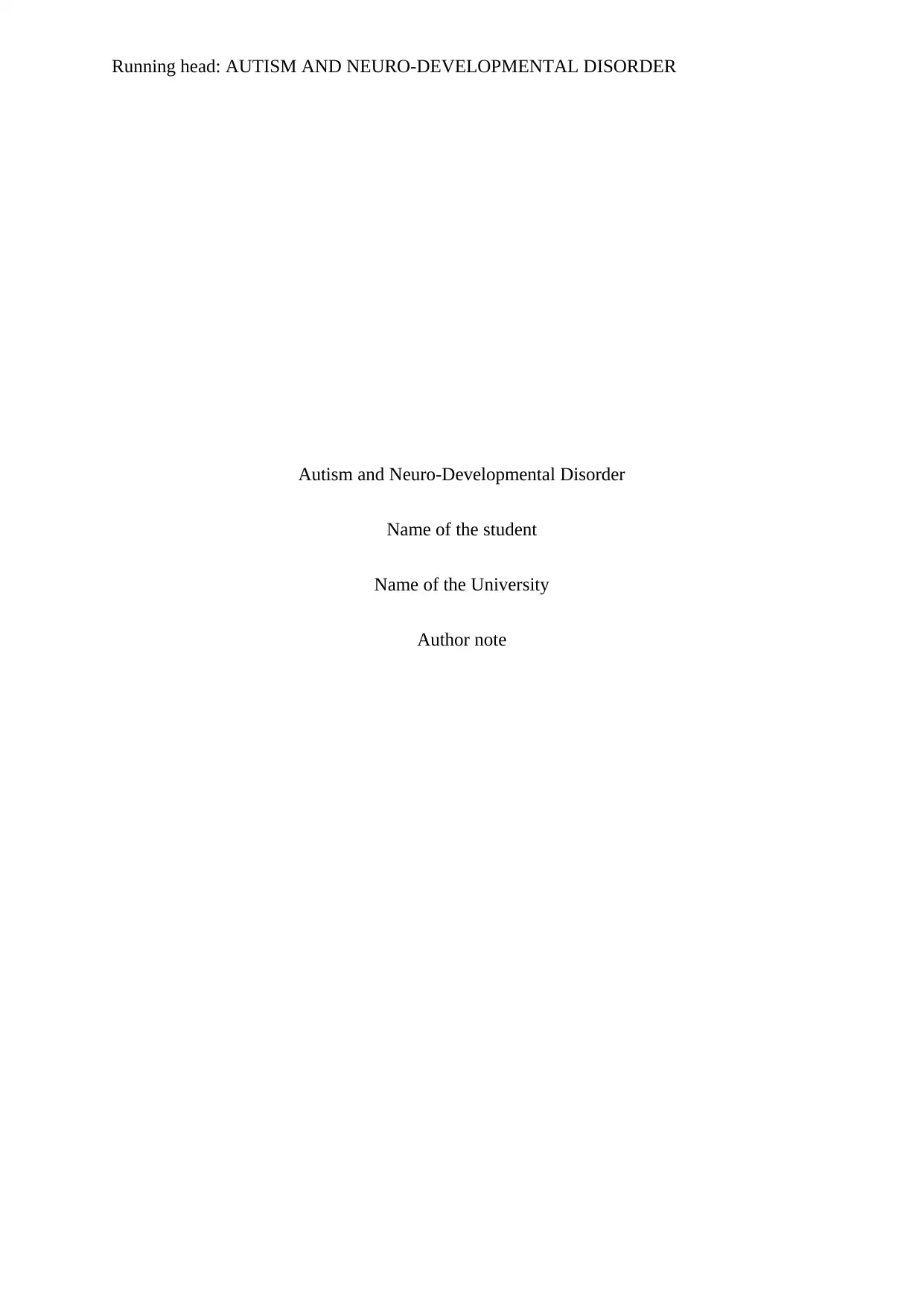
Running head: AUTISM AND NEURO-DEVELOPMENTAL DISORDER
Autism and Neuro-Developmental Disorder
Name of the student
Name of the University
Author note
Autism and Neuro-Developmental Disorder
Name of the student
Name of the University
Author note
Paraphrase This Document
Need a fresh take? Get an instant paraphrase of this document with our AI Paraphraser
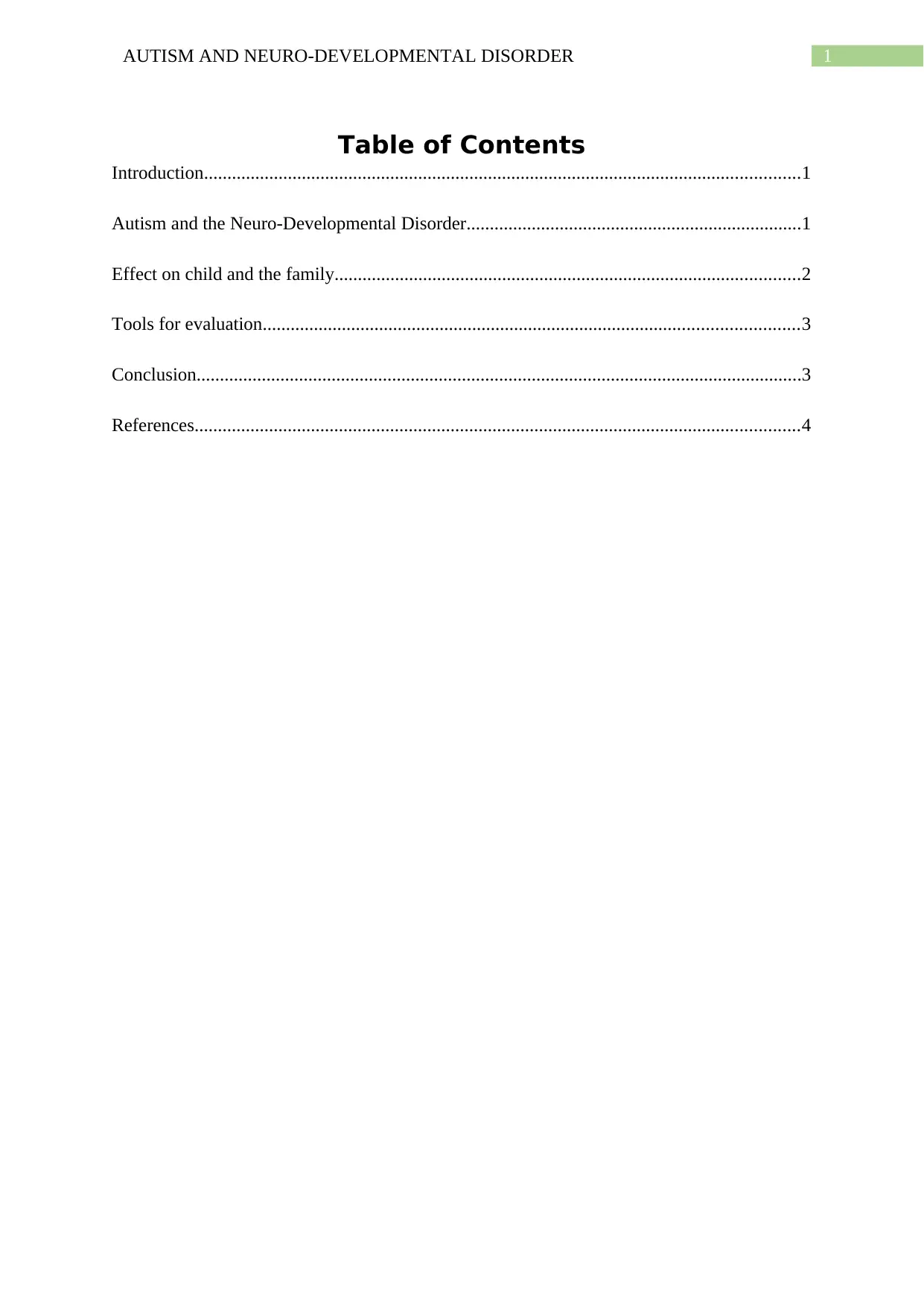
1AUTISM AND NEURO-DEVELOPMENTAL DISORDER
Table of Contents
Introduction................................................................................................................................1
Autism and the Neuro-Developmental Disorder........................................................................1
Effect on child and the family....................................................................................................2
Tools for evaluation...................................................................................................................3
Conclusion..................................................................................................................................3
References..................................................................................................................................4
Table of Contents
Introduction................................................................................................................................1
Autism and the Neuro-Developmental Disorder........................................................................1
Effect on child and the family....................................................................................................2
Tools for evaluation...................................................................................................................3
Conclusion..................................................................................................................................3
References..................................................................................................................................4
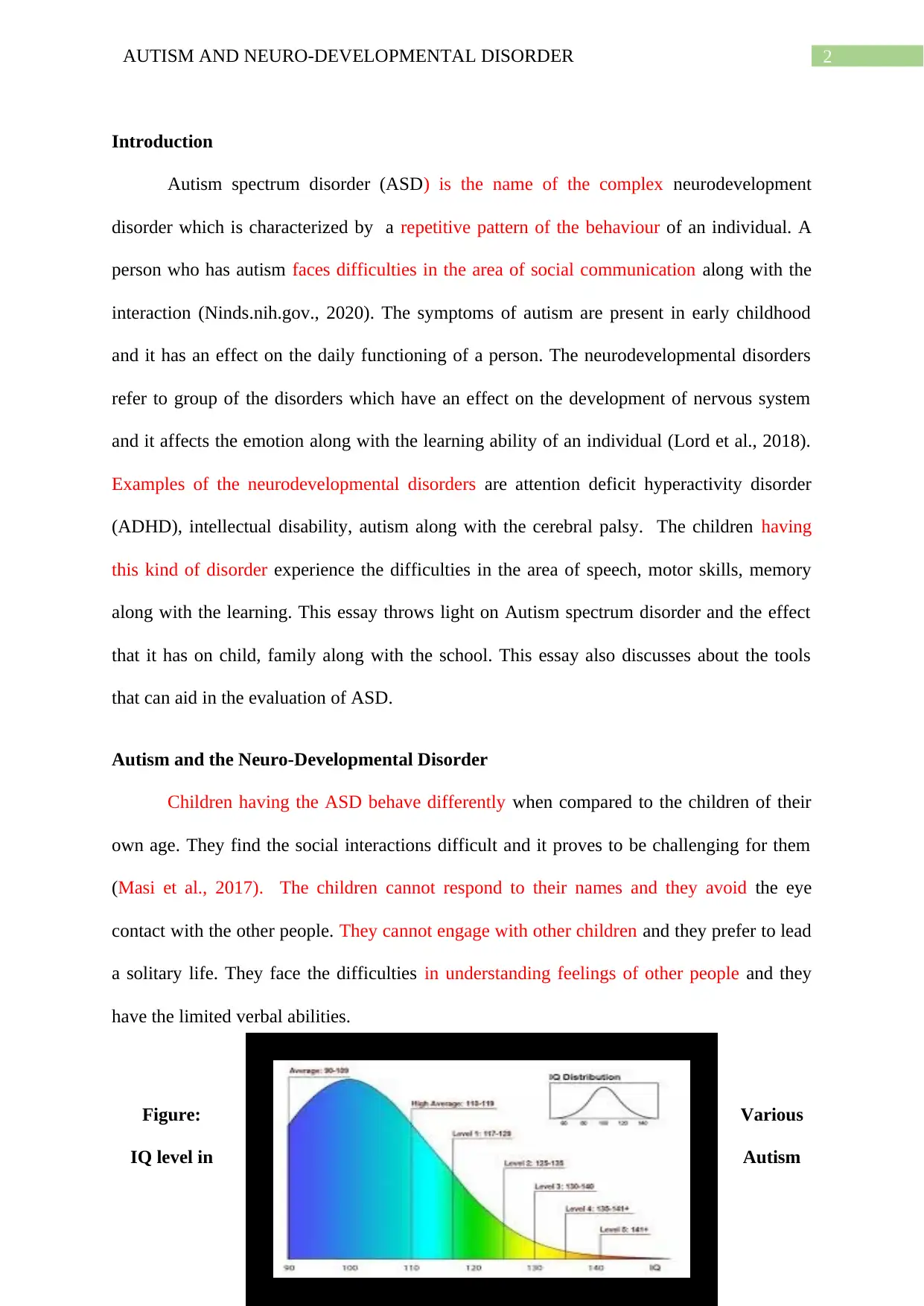
2AUTISM AND NEURO-DEVELOPMENTAL DISORDER
Introduction
Autism spectrum disorder (ASD) is the name of the complex neurodevelopment
disorder which is characterized by a repetitive pattern of the behaviour of an individual. A
person who has autism faces difficulties in the area of social communication along with the
interaction (Ninds.nih.gov., 2020). The symptoms of autism are present in early childhood
and it has an effect on the daily functioning of a person. The neurodevelopmental disorders
refer to group of the disorders which have an effect on the development of nervous system
and it affects the emotion along with the learning ability of an individual (Lord et al., 2018).
Examples of the neurodevelopmental disorders are attention deficit hyperactivity disorder
(ADHD), intellectual disability, autism along with the cerebral palsy. The children having
this kind of disorder experience the difficulties in the area of speech, motor skills, memory
along with the learning. This essay throws light on Autism spectrum disorder and the effect
that it has on child, family along with the school. This essay also discusses about the tools
that can aid in the evaluation of ASD.
Autism and the Neuro-Developmental Disorder
Children having the ASD behave differently when compared to the children of their
own age. They find the social interactions difficult and it proves to be challenging for them
(Masi et al., 2017). The children cannot respond to their names and they avoid the eye
contact with the other people. They cannot engage with other children and they prefer to lead
a solitary life. They face the difficulties in understanding feelings of other people and they
have the limited verbal abilities.
Figure: Various
IQ level in Autism
Introduction
Autism spectrum disorder (ASD) is the name of the complex neurodevelopment
disorder which is characterized by a repetitive pattern of the behaviour of an individual. A
person who has autism faces difficulties in the area of social communication along with the
interaction (Ninds.nih.gov., 2020). The symptoms of autism are present in early childhood
and it has an effect on the daily functioning of a person. The neurodevelopmental disorders
refer to group of the disorders which have an effect on the development of nervous system
and it affects the emotion along with the learning ability of an individual (Lord et al., 2018).
Examples of the neurodevelopmental disorders are attention deficit hyperactivity disorder
(ADHD), intellectual disability, autism along with the cerebral palsy. The children having
this kind of disorder experience the difficulties in the area of speech, motor skills, memory
along with the learning. This essay throws light on Autism spectrum disorder and the effect
that it has on child, family along with the school. This essay also discusses about the tools
that can aid in the evaluation of ASD.
Autism and the Neuro-Developmental Disorder
Children having the ASD behave differently when compared to the children of their
own age. They find the social interactions difficult and it proves to be challenging for them
(Masi et al., 2017). The children cannot respond to their names and they avoid the eye
contact with the other people. They cannot engage with other children and they prefer to lead
a solitary life. They face the difficulties in understanding feelings of other people and they
have the limited verbal abilities.
Figure: Various
IQ level in Autism
⊘ This is a preview!⊘
Do you want full access?
Subscribe today to unlock all pages.

Trusted by 1+ million students worldwide
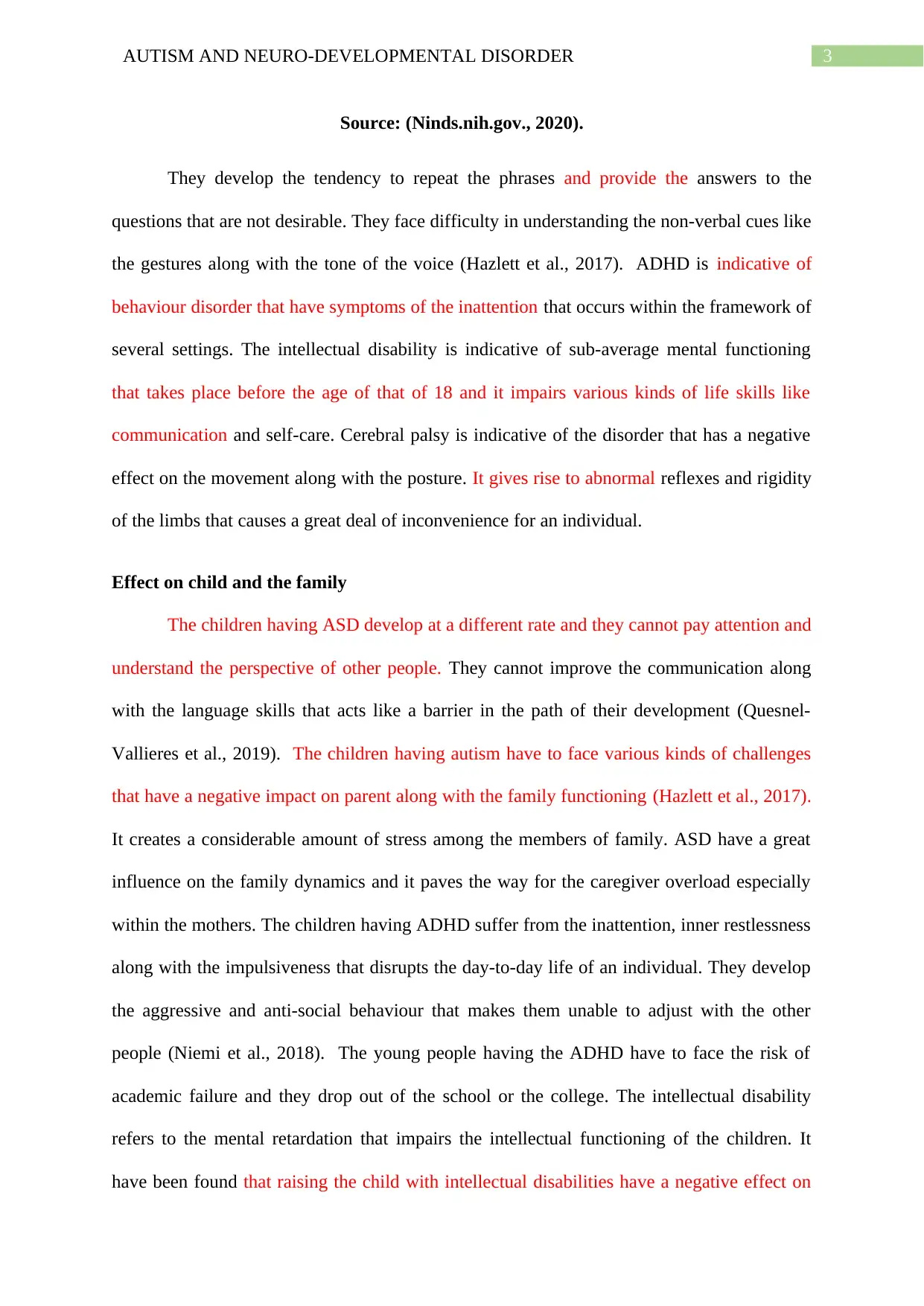
3AUTISM AND NEURO-DEVELOPMENTAL DISORDER
Source: (Ninds.nih.gov., 2020).
They develop the tendency to repeat the phrases and provide the answers to the
questions that are not desirable. They face difficulty in understanding the non-verbal cues like
the gestures along with the tone of the voice (Hazlett et al., 2017). ADHD is indicative of
behaviour disorder that have symptoms of the inattention that occurs within the framework of
several settings. The intellectual disability is indicative of sub-average mental functioning
that takes place before the age of that of 18 and it impairs various kinds of life skills like
communication and self-care. Cerebral palsy is indicative of the disorder that has a negative
effect on the movement along with the posture. It gives rise to abnormal reflexes and rigidity
of the limbs that causes a great deal of inconvenience for an individual.
Effect on child and the family
The children having ASD develop at a different rate and they cannot pay attention and
understand the perspective of other people. They cannot improve the communication along
with the language skills that acts like a barrier in the path of their development (Quesnel-
Vallieres et al., 2019). The children having autism have to face various kinds of challenges
that have a negative impact on parent along with the family functioning (Hazlett et al., 2017).
It creates a considerable amount of stress among the members of family. ASD have a great
influence on the family dynamics and it paves the way for the caregiver overload especially
within the mothers. The children having ADHD suffer from the inattention, inner restlessness
along with the impulsiveness that disrupts the day-to-day life of an individual. They develop
the aggressive and anti-social behaviour that makes them unable to adjust with the other
people (Niemi et al., 2018). The young people having the ADHD have to face the risk of
academic failure and they drop out of the school or the college. The intellectual disability
refers to the mental retardation that impairs the intellectual functioning of the children. It
have been found that raising the child with intellectual disabilities have a negative effect on
Source: (Ninds.nih.gov., 2020).
They develop the tendency to repeat the phrases and provide the answers to the
questions that are not desirable. They face difficulty in understanding the non-verbal cues like
the gestures along with the tone of the voice (Hazlett et al., 2017). ADHD is indicative of
behaviour disorder that have symptoms of the inattention that occurs within the framework of
several settings. The intellectual disability is indicative of sub-average mental functioning
that takes place before the age of that of 18 and it impairs various kinds of life skills like
communication and self-care. Cerebral palsy is indicative of the disorder that has a negative
effect on the movement along with the posture. It gives rise to abnormal reflexes and rigidity
of the limbs that causes a great deal of inconvenience for an individual.
Effect on child and the family
The children having ASD develop at a different rate and they cannot pay attention and
understand the perspective of other people. They cannot improve the communication along
with the language skills that acts like a barrier in the path of their development (Quesnel-
Vallieres et al., 2019). The children having autism have to face various kinds of challenges
that have a negative impact on parent along with the family functioning (Hazlett et al., 2017).
It creates a considerable amount of stress among the members of family. ASD have a great
influence on the family dynamics and it paves the way for the caregiver overload especially
within the mothers. The children having ADHD suffer from the inattention, inner restlessness
along with the impulsiveness that disrupts the day-to-day life of an individual. They develop
the aggressive and anti-social behaviour that makes them unable to adjust with the other
people (Niemi et al., 2018). The young people having the ADHD have to face the risk of
academic failure and they drop out of the school or the college. The intellectual disability
refers to the mental retardation that impairs the intellectual functioning of the children. It
have been found that raising the child with intellectual disabilities have a negative effect on
Paraphrase This Document
Need a fresh take? Get an instant paraphrase of this document with our AI Paraphraser
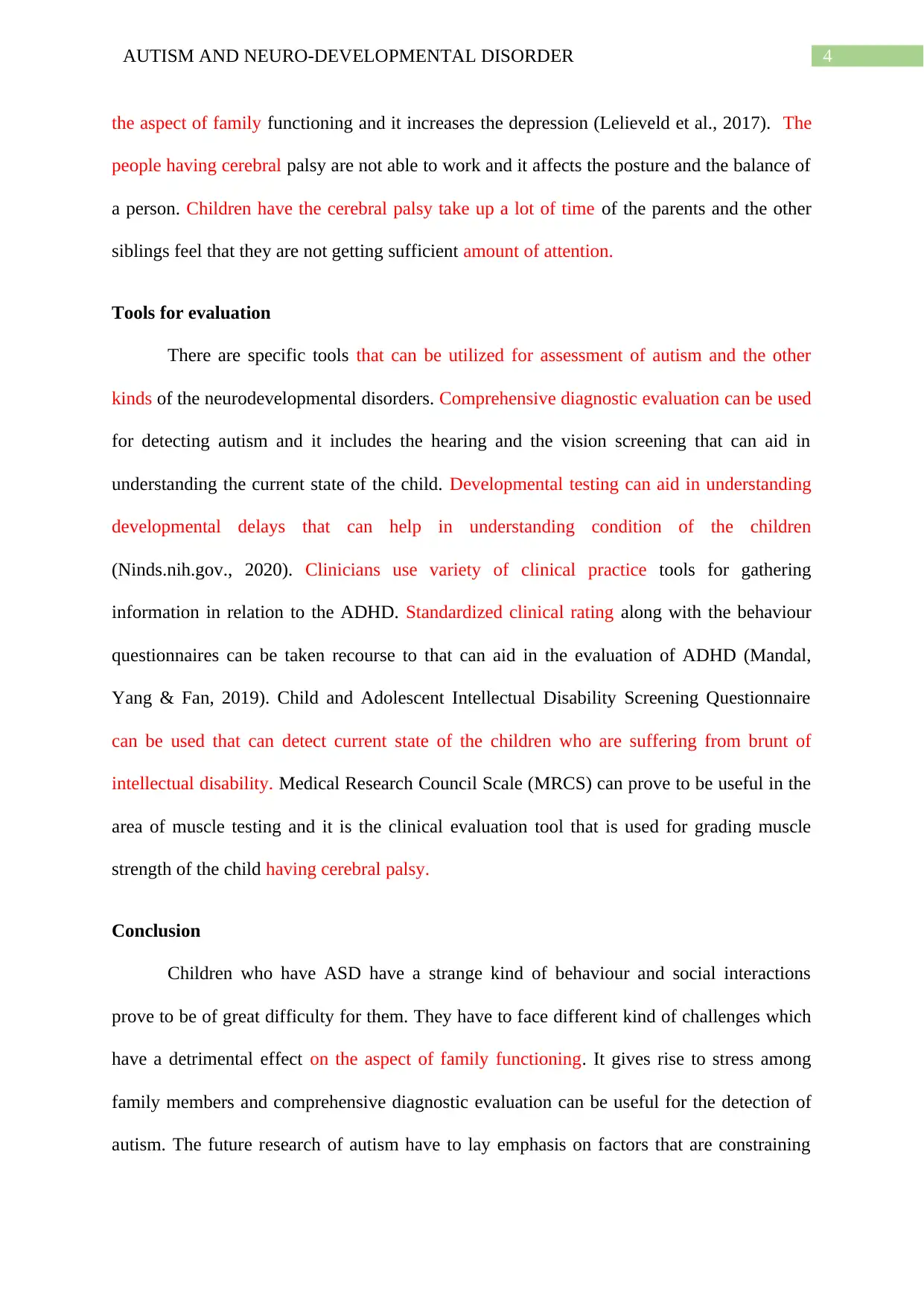
4AUTISM AND NEURO-DEVELOPMENTAL DISORDER
the aspect of family functioning and it increases the depression (Lelieveld et al., 2017). The
people having cerebral palsy are not able to work and it affects the posture and the balance of
a person. Children have the cerebral palsy take up a lot of time of the parents and the other
siblings feel that they are not getting sufficient amount of attention.
Tools for evaluation
There are specific tools that can be utilized for assessment of autism and the other
kinds of the neurodevelopmental disorders. Comprehensive diagnostic evaluation can be used
for detecting autism and it includes the hearing and the vision screening that can aid in
understanding the current state of the child. Developmental testing can aid in understanding
developmental delays that can help in understanding condition of the children
(Ninds.nih.gov., 2020). Clinicians use variety of clinical practice tools for gathering
information in relation to the ADHD. Standardized clinical rating along with the behaviour
questionnaires can be taken recourse to that can aid in the evaluation of ADHD (Mandal,
Yang & Fan, 2019). Child and Adolescent Intellectual Disability Screening Questionnaire
can be used that can detect current state of the children who are suffering from brunt of
intellectual disability. Medical Research Council Scale (MRCS) can prove to be useful in the
area of muscle testing and it is the clinical evaluation tool that is used for grading muscle
strength of the child having cerebral palsy.
Conclusion
Children who have ASD have a strange kind of behaviour and social interactions
prove to be of great difficulty for them. They have to face different kind of challenges which
have a detrimental effect on the aspect of family functioning. It gives rise to stress among
family members and comprehensive diagnostic evaluation can be useful for the detection of
autism. The future research of autism have to lay emphasis on factors that are constraining
the aspect of family functioning and it increases the depression (Lelieveld et al., 2017). The
people having cerebral palsy are not able to work and it affects the posture and the balance of
a person. Children have the cerebral palsy take up a lot of time of the parents and the other
siblings feel that they are not getting sufficient amount of attention.
Tools for evaluation
There are specific tools that can be utilized for assessment of autism and the other
kinds of the neurodevelopmental disorders. Comprehensive diagnostic evaluation can be used
for detecting autism and it includes the hearing and the vision screening that can aid in
understanding the current state of the child. Developmental testing can aid in understanding
developmental delays that can help in understanding condition of the children
(Ninds.nih.gov., 2020). Clinicians use variety of clinical practice tools for gathering
information in relation to the ADHD. Standardized clinical rating along with the behaviour
questionnaires can be taken recourse to that can aid in the evaluation of ADHD (Mandal,
Yang & Fan, 2019). Child and Adolescent Intellectual Disability Screening Questionnaire
can be used that can detect current state of the children who are suffering from brunt of
intellectual disability. Medical Research Council Scale (MRCS) can prove to be useful in the
area of muscle testing and it is the clinical evaluation tool that is used for grading muscle
strength of the child having cerebral palsy.
Conclusion
Children who have ASD have a strange kind of behaviour and social interactions
prove to be of great difficulty for them. They have to face different kind of challenges which
have a detrimental effect on the aspect of family functioning. It gives rise to stress among
family members and comprehensive diagnostic evaluation can be useful for the detection of
autism. The future research of autism have to lay emphasis on factors that are constraining
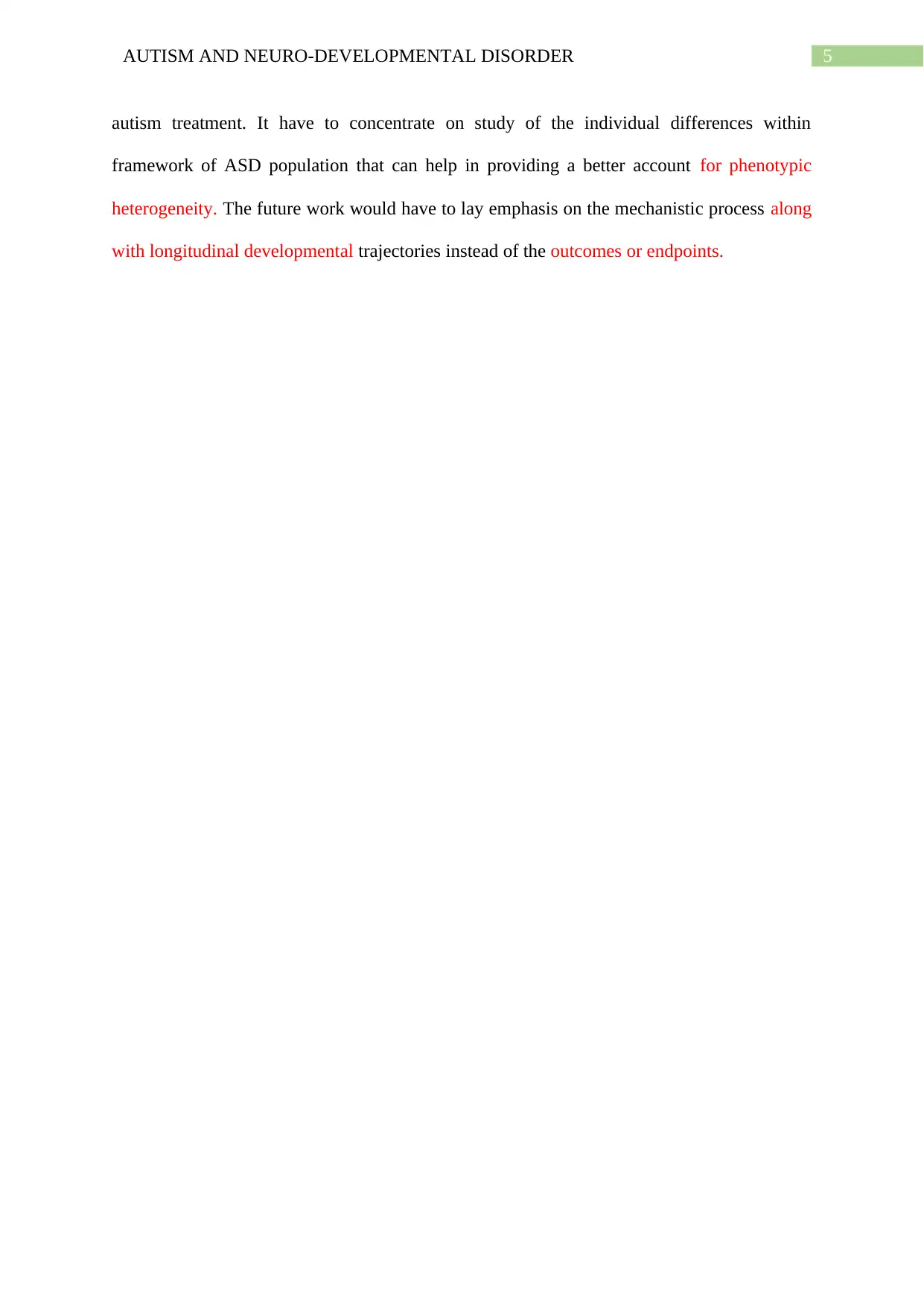
5AUTISM AND NEURO-DEVELOPMENTAL DISORDER
autism treatment. It have to concentrate on study of the individual differences within
framework of ASD population that can help in providing a better account for phenotypic
heterogeneity. The future work would have to lay emphasis on the mechanistic process along
with longitudinal developmental trajectories instead of the outcomes or endpoints.
autism treatment. It have to concentrate on study of the individual differences within
framework of ASD population that can help in providing a better account for phenotypic
heterogeneity. The future work would have to lay emphasis on the mechanistic process along
with longitudinal developmental trajectories instead of the outcomes or endpoints.
⊘ This is a preview!⊘
Do you want full access?
Subscribe today to unlock all pages.

Trusted by 1+ million students worldwide
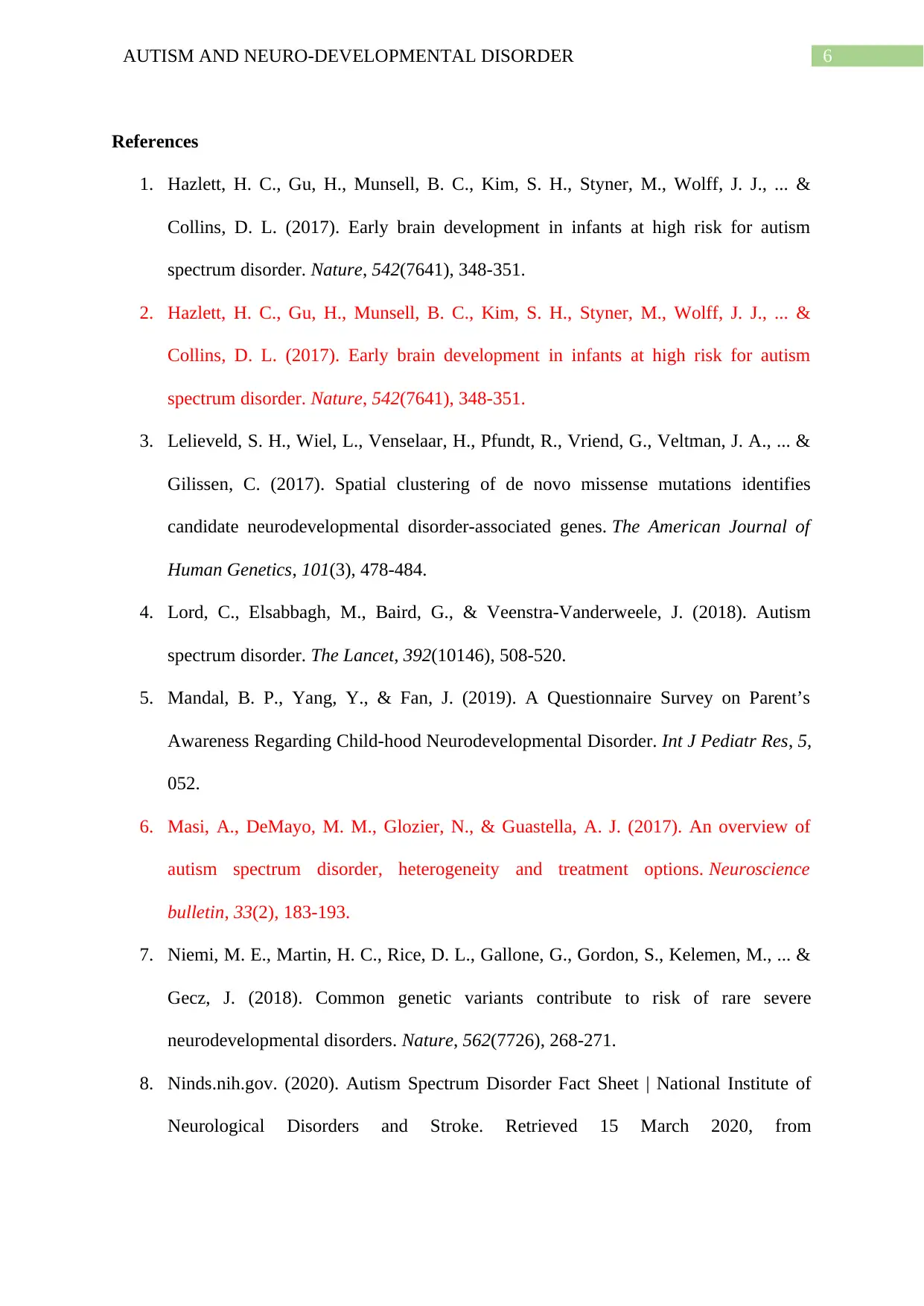
6AUTISM AND NEURO-DEVELOPMENTAL DISORDER
References
1. Hazlett, H. C., Gu, H., Munsell, B. C., Kim, S. H., Styner, M., Wolff, J. J., ... &
Collins, D. L. (2017). Early brain development in infants at high risk for autism
spectrum disorder. Nature, 542(7641), 348-351.
2. Hazlett, H. C., Gu, H., Munsell, B. C., Kim, S. H., Styner, M., Wolff, J. J., ... &
Collins, D. L. (2017). Early brain development in infants at high risk for autism
spectrum disorder. Nature, 542(7641), 348-351.
3. Lelieveld, S. H., Wiel, L., Venselaar, H., Pfundt, R., Vriend, G., Veltman, J. A., ... &
Gilissen, C. (2017). Spatial clustering of de novo missense mutations identifies
candidate neurodevelopmental disorder-associated genes. The American Journal of
Human Genetics, 101(3), 478-484.
4. Lord, C., Elsabbagh, M., Baird, G., & Veenstra-Vanderweele, J. (2018). Autism
spectrum disorder. The Lancet, 392(10146), 508-520.
5. Mandal, B. P., Yang, Y., & Fan, J. (2019). A Questionnaire Survey on Parent’s
Awareness Regarding Child-hood Neurodevelopmental Disorder. Int J Pediatr Res, 5,
052.
6. Masi, A., DeMayo, M. M., Glozier, N., & Guastella, A. J. (2017). An overview of
autism spectrum disorder, heterogeneity and treatment options. Neuroscience
bulletin, 33(2), 183-193.
7. Niemi, M. E., Martin, H. C., Rice, D. L., Gallone, G., Gordon, S., Kelemen, M., ... &
Gecz, J. (2018). Common genetic variants contribute to risk of rare severe
neurodevelopmental disorders. Nature, 562(7726), 268-271.
8. Ninds.nih.gov. (2020). Autism Spectrum Disorder Fact Sheet | National Institute of
Neurological Disorders and Stroke. Retrieved 15 March 2020, from
References
1. Hazlett, H. C., Gu, H., Munsell, B. C., Kim, S. H., Styner, M., Wolff, J. J., ... &
Collins, D. L. (2017). Early brain development in infants at high risk for autism
spectrum disorder. Nature, 542(7641), 348-351.
2. Hazlett, H. C., Gu, H., Munsell, B. C., Kim, S. H., Styner, M., Wolff, J. J., ... &
Collins, D. L. (2017). Early brain development in infants at high risk for autism
spectrum disorder. Nature, 542(7641), 348-351.
3. Lelieveld, S. H., Wiel, L., Venselaar, H., Pfundt, R., Vriend, G., Veltman, J. A., ... &
Gilissen, C. (2017). Spatial clustering of de novo missense mutations identifies
candidate neurodevelopmental disorder-associated genes. The American Journal of
Human Genetics, 101(3), 478-484.
4. Lord, C., Elsabbagh, M., Baird, G., & Veenstra-Vanderweele, J. (2018). Autism
spectrum disorder. The Lancet, 392(10146), 508-520.
5. Mandal, B. P., Yang, Y., & Fan, J. (2019). A Questionnaire Survey on Parent’s
Awareness Regarding Child-hood Neurodevelopmental Disorder. Int J Pediatr Res, 5,
052.
6. Masi, A., DeMayo, M. M., Glozier, N., & Guastella, A. J. (2017). An overview of
autism spectrum disorder, heterogeneity and treatment options. Neuroscience
bulletin, 33(2), 183-193.
7. Niemi, M. E., Martin, H. C., Rice, D. L., Gallone, G., Gordon, S., Kelemen, M., ... &
Gecz, J. (2018). Common genetic variants contribute to risk of rare severe
neurodevelopmental disorders. Nature, 562(7726), 268-271.
8. Ninds.nih.gov. (2020). Autism Spectrum Disorder Fact Sheet | National Institute of
Neurological Disorders and Stroke. Retrieved 15 March 2020, from
Paraphrase This Document
Need a fresh take? Get an instant paraphrase of this document with our AI Paraphraser
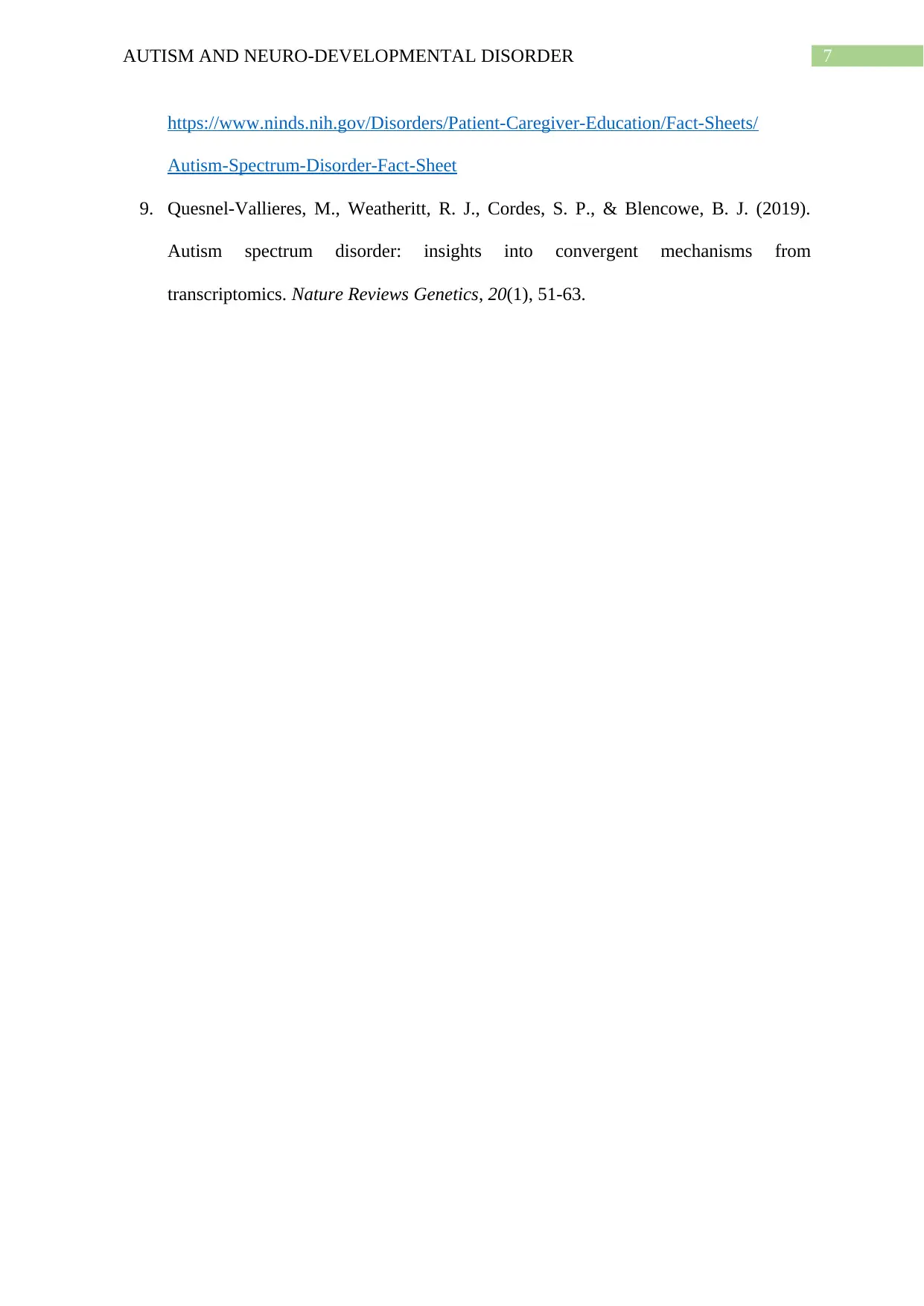
7AUTISM AND NEURO-DEVELOPMENTAL DISORDER
https://www.ninds.nih.gov/Disorders/Patient-Caregiver-Education/Fact-Sheets/
Autism-Spectrum-Disorder-Fact-Sheet
9. Quesnel-Vallieres, M., Weatheritt, R. J., Cordes, S. P., & Blencowe, B. J. (2019).
Autism spectrum disorder: insights into convergent mechanisms from
transcriptomics. Nature Reviews Genetics, 20(1), 51-63.
https://www.ninds.nih.gov/Disorders/Patient-Caregiver-Education/Fact-Sheets/
Autism-Spectrum-Disorder-Fact-Sheet
9. Quesnel-Vallieres, M., Weatheritt, R. J., Cordes, S. P., & Blencowe, B. J. (2019).
Autism spectrum disorder: insights into convergent mechanisms from
transcriptomics. Nature Reviews Genetics, 20(1), 51-63.
1 out of 8
Related Documents
Your All-in-One AI-Powered Toolkit for Academic Success.
+13062052269
info@desklib.com
Available 24*7 on WhatsApp / Email
![[object Object]](/_next/static/media/star-bottom.7253800d.svg)
Unlock your academic potential
Copyright © 2020–2025 A2Z Services. All Rights Reserved. Developed and managed by ZUCOL.





